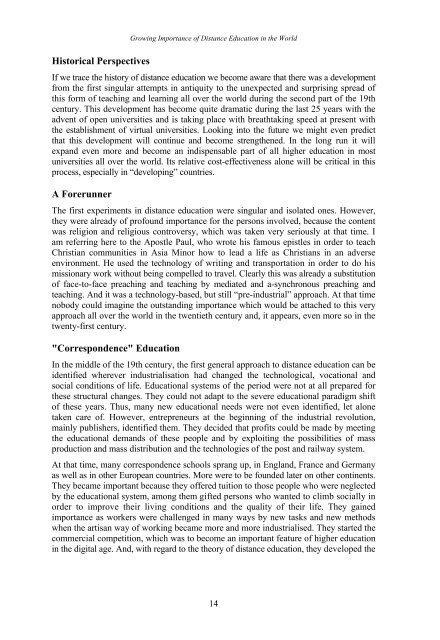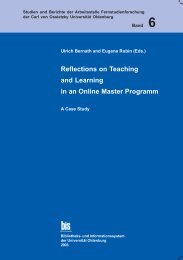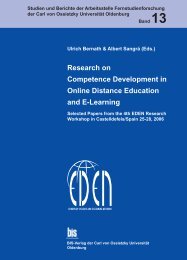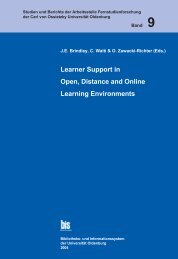Distance Education in Transition - Master of Distance Education ...
Distance Education in Transition - Master of Distance Education ...
Distance Education in Transition - Master of Distance Education ...
Create successful ePaper yourself
Turn your PDF publications into a flip-book with our unique Google optimized e-Paper software.
Historical Perspectives<br />
Grow<strong>in</strong>g Importance <strong>of</strong> <strong>Distance</strong> <strong>Education</strong> <strong>in</strong> the World<br />
If we trace the history <strong>of</strong> distance education we become aware that there was a development<br />
from the first s<strong>in</strong>gular attempts <strong>in</strong> antiquity to the unexpected and surpris<strong>in</strong>g spread <strong>of</strong><br />
this form <strong>of</strong> teach<strong>in</strong>g and learn<strong>in</strong>g all over the world dur<strong>in</strong>g the second part <strong>of</strong> the 19th<br />
century. This development has become quite dramatic dur<strong>in</strong>g the last 25 years with the<br />
advent <strong>of</strong> open universities and is tak<strong>in</strong>g place with breathtak<strong>in</strong>g speed at present with<br />
the establishment <strong>of</strong> virtual universities. Look<strong>in</strong>g <strong>in</strong>to the future we might even predict<br />
that this development will cont<strong>in</strong>ue and become strengthened. In the long run it will<br />
expand even more and become an <strong>in</strong>dispensable part <strong>of</strong> all higher education <strong>in</strong> most<br />
universities all over the world. Its relative cost-effectiveness alone will be critical <strong>in</strong> this<br />
process, especially <strong>in</strong> “develop<strong>in</strong>g” countries.<br />
A Forerunner<br />
The first experiments <strong>in</strong> distance education were s<strong>in</strong>gular and isolated ones. However,<br />
they were already <strong>of</strong> pr<strong>of</strong>ound importance for the persons <strong>in</strong>volved, because the content<br />
was religion and religious controversy, which was taken very seriously at that time. I<br />
am referr<strong>in</strong>g here to the Apostle Paul, who wrote his famous epistles <strong>in</strong> order to teach<br />
Christian communities <strong>in</strong> Asia M<strong>in</strong>or how to lead a life as Christians <strong>in</strong> an adverse<br />
environment. He used the technology <strong>of</strong> writ<strong>in</strong>g and transportation <strong>in</strong> order to do his<br />
missionary work without be<strong>in</strong>g compelled to travel. Clearly this was already a substitution<br />
<strong>of</strong> face-to-face preach<strong>in</strong>g and teach<strong>in</strong>g by mediated and a-synchronous preach<strong>in</strong>g and<br />
teach<strong>in</strong>g. And it was a technology-based, but still “pre-<strong>in</strong>dustrial” approach. At that time<br />
nobody could imag<strong>in</strong>e the outstand<strong>in</strong>g importance which would be attached to this very<br />
approach all over the world <strong>in</strong> the twentieth century and, it appears, even more so <strong>in</strong> the<br />
twenty-first century.<br />
"Correspondence" <strong>Education</strong><br />
In the middle <strong>of</strong> the 19th century, the first general approach to distance education can be<br />
identified wherever <strong>in</strong>dustrialisation had changed the technological, vocational and<br />
social conditions <strong>of</strong> life. <strong>Education</strong>al systems <strong>of</strong> the period were not at all prepared for<br />
these structural changes. They could not adapt to the severe educational paradigm shift<br />
<strong>of</strong> these years. Thus, many new educational needs were not even identified, let alone<br />
taken care <strong>of</strong>. However, entrepreneurs at the beg<strong>in</strong>n<strong>in</strong>g <strong>of</strong> the <strong>in</strong>dustrial revolution,<br />
ma<strong>in</strong>ly publishers, identified them. They decided that pr<strong>of</strong>its could be made by meet<strong>in</strong>g<br />
the educational demands <strong>of</strong> these people and by exploit<strong>in</strong>g the possibilities <strong>of</strong> mass<br />
production and mass distribution and the technologies <strong>of</strong> the post and railway system.<br />
At that time, many correspondence schools sprang up, <strong>in</strong> England, France and Germany<br />
as well as <strong>in</strong> other European countries. More were to be founded later on other cont<strong>in</strong>ents.<br />
They became important because they <strong>of</strong>fered tuition to those people who were neglected<br />
by the educational system, among them gifted persons who wanted to climb socially <strong>in</strong><br />
order to improve their liv<strong>in</strong>g conditions and the quality <strong>of</strong> their life. They ga<strong>in</strong>ed<br />
importance as workers were challenged <strong>in</strong> many ways by new tasks and new methods<br />
when the artisan way <strong>of</strong> work<strong>in</strong>g became more and more <strong>in</strong>dustrialised. They started the<br />
commercial competition, which was to become an important feature <strong>of</strong> higher education<br />
<strong>in</strong> the digital age. And, with regard to the theory <strong>of</strong> distance education, they developed the<br />
14





